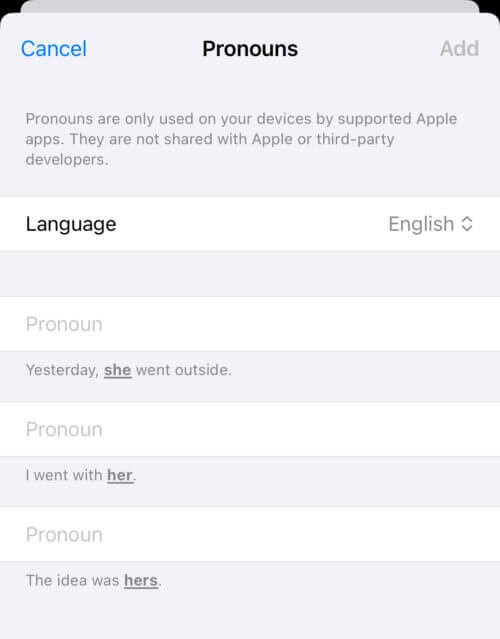In iOS 17, you are now able to add pronouns to contacts, including your own contact card. This is a good thing, but at least one important pronoun case is missing from the “English” options.
The cases included are:
- Subjective (“Yesterday, she went outside.”)
- Objective (“I went with her.”)
- Possessive pronoun (“The idea was hers.”)

These three cases mirror the common “she/her/hers” structure used to communicate pronouns on social platforms like Twitter and Zoom; as such, they may seem complete, but they aren’t.
The missing case is the possessive adjective: “It was her idea.”
This may seem redundant, because in the declension of feminine pronouns, the possessive adjective is the same as the objective: “her.”
But in masculine pronouns, the possessive adjective is the same as the possessive pronoun: “his” (as in, “It was his idea”).
| Case | Feminine | Masculine |
|---|---|---|
| Subjective | She | He |
| Objective | Her | Him |
| Possessive pronoun | Hers | His |
| Possessive adjective | Her | His |
This isn’t a problem when interacting with people — we know how to decline the common feminine and masculine pronouns, so we know which form to use for the possessive adjective.
But because the iOS 17 UI doesn’t have a field for the possessive adjective, the OS and apps that have access to these fields — which have to behave programmatically — can’t know what to use for that case.
If I’m writing an app and I want the UI to say, “Would you like to call her?” in reference to some contact of yours, I can use the objective pronoun field. But if I want the UI to say “Her birthday is coming up” (the possessive adjective), I don’t have the necessary information.
I can try to guess, based on what I know about the declension of these common pronouns. But what about uncommon ones, like Ze or Xe? Anything I want to use will have to be hard-coded.
This is not even to mention the reflexive case — “She was proud of herself” — which is entirely absent.